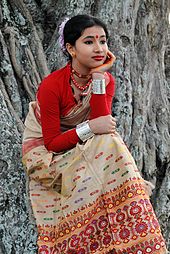CLOTHING IN INDIA
- Clothing in India varies depending on the different ethnicity, geography, climate and cultural traditions of the people of each region of India. Historically, male and female clothing has evolved from simple Langotas, and loincloths to cover the body to elaborate costumes not only used in daily wear but also on festive occasions as well as rituals and dance performances. In urban areas, western clothing is common and uniformly worn by people of all social levels. India also has a great diversity in terms of weaves, fibers, colours and material of clothing. Colour codes are followed in clothing based on the religion and ritual concerned. For instance,Hindu ladies wear white clothes to indicate mourning, while Parsis and Christians wear white to weddings. The clothing in India also encompasses the wide variety of Indian embroidery.
Traditional clothing
Sari and wrapped garments
- A saree or sar a female garment in the Indian subcontinent.[24] A sari is a strip of unstitched cloth, ranging from four to nine meters in length, that is draped over the body in various styles. These include: Sambalpuri Saree from East, Mysore silk and Ilkal of Karnataka and, Kanchipuram of Tamil Nadu from South, Paithani from West and anarasi from North among others.[25] The most common style is for the sari to be wrapped around the waist, with one end then draped over the shoulder baring the midriff.[24] The sari is usually worn over a petticoat.[26] Blouse may be "backless" or of a halter neck style. These are usually more dressy with a lot of embellishments such as mirrors or embroidery and may be worn on special occasions. Women in the armed forces, when wearing a sari uniform, don a half-sleeve shirt tucked in at the waist. Teenage girls wear half-sarees, a three piece set consisting of a langa, a choli and a stole wrapped over it like a saree. Women usually wear full sarees. Indian wedding saris are typically red, a tradition that goes back to India's pre-modern history

- Saris are usually known with different names in different places. In Kerala, white saris with golden border, are known as kavanis and are worn on special occasions. A simple white sari, worn as a daily wear, is called a mundu. Saris are called pudavai in Tamil Nadu. In Karnataka, saris are called Seere The traditional production of handloom sarees is important to economic development in rural communities.
- Mundum Neriyathum
 The bottom portion, draped from the waist downwards is called the Mekhela (Assamese: মেখেলা). It is in the form of a sarong—very wide cylinder of cloth—that is folded into pleats to fit around the waist and tucked in. The folds are to the right, as opposed to the pleats in the Nivi style of the saree, which are folded to the left. Strings are never used to tie the mekhela around the waist, though an underskirt with a string is often used.
The bottom portion, draped from the waist downwards is called the Mekhela (Assamese: মেখেলা). It is in the form of a sarong—very wide cylinder of cloth—that is folded into pleats to fit around the waist and tucked in. The folds are to the right, as opposed to the pleats in the Nivi style of the saree, which are folded to the left. Strings are never used to tie the mekhela around the waist, though an underskirt with a string is often used.- Anarkali Suit
- Langa - Voni/Dhavani
Salwar Kameez
The salwar kameez is the traditional wear of women in Punjab, Haryana and Himachal Pradesh and is called the Punjabi suit which is most common in the northwestern part of India (Punjab region). The Punjabi suit also includes the "churidaar" and "kurta" ensemble which is also popular in Southern India where it is known as the "churidaar".[32]
The salwar kameez has become the most popular dress for females. It consists of loose trousers (the salwar) narrow at the ankles, topped by a tunic top (the kameez) Women generally wear a dupatta or odani (Veil) with salwar kameez to cover their head and shoulders. It is always worn with a scarf called a dupatta, which is used to cover the head and drawn over the bosom.
Churidaar
The anarkali suit is made up of a long, frock-style top and features a slim fitted bottom.The anarkali is an extremely desirable style that is adorned by women located in Northern India, Pakistan and The Middle East. The anarkali suit varies in many different lengths and embroideries including floor length anarkali styles. Many women will also opt for heavier embroidered anarkali suits on wedding functions and events. Indian women wear anarkali suits on various other occasions as well such as traditional festivals,casual lunch, anniversary celebrations etc. The kameez of the anarkali can be sleevelesss or with sleeves ranging from cap- to wrist-length.[38]
No comments:
Post a Comment